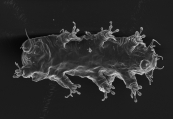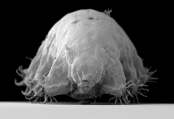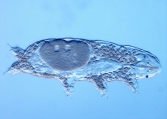Tardigrada source details
Phillips, L.M., R.I. Leihy & S.L. Chown. (2022). Improving species‐based area protection in Antarctica. Conservation Biology. 36(4): e13885.Aug 2022.
434742
10.1111/cobi.13885 [view]
Phillips, L.M., R.I. Leihy & S.L. Chown
2022
Improving species‐based area protection in Antarctica.
Conservation Biology
36(4): e13885.Aug 2022
Publication
Area protection is a major mechanism deployed for environmental conservation in Antarctica. Yet, the Antarctic protected areas network is widely acknowledged as inadequate, in part because the criteria for area protection south of 60°S are not fully applied. The most poorly explored of these criteria is the type locality of species, which provides the primary legal means for Antarctic species-based area protection and a method for conserving species even if little is known about their habitat or distribution. The type locality criterion has not been systematically assessed since its incorporation into the Protocol on Environmental Protection to the Antarctic Treaty in 1991, so the extent to which the criterion is being met or might be useful for area protection is largely unknown. To address the matter, we created and analyzed a comprehensive database of Antarctic type localities of terrestrial and lacustrine lichens, plants, and animals. We compiled the database via a literature search of key taxonomic and geographic terms and then analyzed the distance between type localities identifiable to a ≤ 25km2 resolution and current Antarctic Specially Protected Areas (ASPAs) and human infrastructure. We used a distance-clustering approach for localities outside current ASPAs to determine candidate protected areas that could contain these unprotected localities. Of the 386 type localities analyzed, 108 were within or overlapped current ASPAs. Inclusion of the remaining 278 type localities in the ASPA network would require the designation of a further 105 protected areas. Twenty-four of these areas included human infrastructure disturbance. Given the slow rate of ASPA designation, growing pace of human impacts on the continent, and the management burden associated with ASPAs, we propose ways in which the type locality criterion might best be deployed. These include a comprehensive, systematic conservation planning approach and an alternative emphasis on the habitat of species, rather than on a single locality.
Date
action
by
Acutuncus antarcticus (Richters, 1904) (additional source)
Adropion greveni (Dastych, 1984) (additional source)
Adropion mauccii (Dastych & McInnes, 1996) (additional source)
Adropion scoticum (Murray, 1905) (additional source)
Adropion tricuspidatum (Binda & Pilato, 2000) accepted as Kararehius tricuspidatum (Binda & Pilato, 2000) (additional source)
Barbaria jenningsi (Dastych, 1984) (basis of record)
Barbaria pseudowendti (Dastych, 1984) accepted as Claxtonia pseudowendti (Dastych, 1984) (basis of record)
Bertolanius volubilis (Durante Pasa & Maucci, 1975) (additional source)
Bryodelphax olszanowskii Kaczmarek, Parnikoza, Gawlak, Esefeld, Peter, Kozeretska & Roszkowska, 2018 (basis of record)
Claxtonia corrugicaudata (McInnes, 2009) (basis of record)
Cryoconicus antiarktos Guidetti, Massa, Bertolani, Rebecchi & Cesari, 2019 (basis of record)
Dactylobiotus ambiguus (Murray, 1907) (additional source)
Dactylobiotus ovimutans Kihm, Kim, McInnes, Zawierucha, Rho, Kang & Park, 2020 (basis of record)
Dastychius improvisus (Dastych, 1984) (additional source)
Dianea papillifera (Murray, 1905) (basis of record)
Diphascon alpinum Murray, 1906 (additional source)
Diphascon chilenense Plate, 1888 (additional source)
Diphascon dastychi Pilato & Binda, 1999 (additional source)
Diphascon higginsi Binda, 1971 (additional source)
Diphascon langhovdense (Sudzuki, 1964) (additional source)
Diphascon mirabilis Dastych, 1984 (additional source)
Diphascon ongulense (Morikawa, 1962) (additional source)
Diphascon pingue (Marcus, 1936) (additional source)
Diphascon polare Pilato & Binda, 1999 (additional source)
Diphascon puchalskii Kaczmarek, Parnikoza, Gawlak, Esefeld, Peter, Kozeretska & Roszkowska, 2018 (basis of record)
Diphascon puniceum (Jennings, 1976) (additional source)
Diphascon rudnickii Kaczmarek, Parnikoza, Gawlak, Esefeld, Peter, Kozeretska & Roszkowska, 2018 (basis of record)
Diphascon sanae Dastych, Ryan & Watkins, 1990 (additional source)
Diphascon victoriae Pilato & Binda, 1999 (additional source)
Echiniscus kerguelensis Richters, 1904 (additional source)
Echiniscus merokensis Richters, 1904 (additional source)
Echiniscus punctus McInnes, 1995 (additional source)
Grevenius asper (Murray, 1906) (basis of record)
Hebesuncus conjungens (Thulin, 1911) (additional source)
Hebesuncus mollispinus Pilato, McInnes & Lisi, 2012 (additional source)
Hebesuncus ryani Dastych & Harris, 1994 (additional source)
Hebesuncus schusteri (Dastych, 1984) (additional source)
Hexapodibius boothi Dastych & McInnes, 1994 (additional source)
Hypsibius allisoni Horning, Schuster & Grigarick, 1978 (additional source)
Hypsibius conwentzii Kaczmarek, Parnikoza, Gawlak, Esefeld, Peter, Kozeretska & Roszkowska, 2018 (basis of record)
Hypsibius dujardini (Doyère, 1840) (additional source)
Isohypsibius laevis McInnes, 1995 accepted as Grevenius laevis (McInnes, 1995) (additional source)
Mesobiotus aradasi (Binda, Pilato & Lisi, 2005) (additional source)
Mesobiotus blocki (Dastych, 1984) (additional source)
Mesobiotus coronatus (de Barros, 1942) (additional source)
Mesobiotus furciger (Murray, 1907) (additional source)
Mesobiotus harmsworthi (Murray, 1907) (additional source)
Mesobiotus hilariae Vecchi, Cesari, Bertolani, Jönsson, Rebecchi & Guidetti, 2016 (additional source)
Mesobiotus krynauwi (Dastych & Harris, 1995) (additional source)
Mesobiotus meridionalis (Richters, 1909) (additional source)
Mesobiotus montanus (Murray, 1910) (additional source)
Mesobiotus mottai (Binda & Pilato, 1994) (additional source)
Mesobiotus polaris (Murray, 1910) (additional source)
Milnesium antarcticum Tumanov, 2006 (additional source)
Milnesium quadrifidum Nederström, 1919 (basis of record)
Milnesium validum Pilato, Sabella, D'Urso & Lisi, 2017 (basis of record)
Minibiotus stuckenbergi (Dastych, Ryan & Watkins, 1990) (additional source)
Minibiotus vinciguerrae Binda & Pilato, 1992 (additional source)
Minibiotus weinerorum (Dastych, 1984) (additional source)
Mixibius felix Pilato, Sabella, D'Urso & Lisi, 2017 (basis of record)
Mixibius saracenus (Pilato, 1973) (additional source)
Mopsechiniscus franciscae Guidetti, Rebecchi, Cesari & McInnes, 2014 (additional source)
Notahypsibius arcticus (Murray, 1907) (basis of record)
Oreella mollis Murray, 1910 (additional source)
Paramacrobiotus fairbanksi Schill, Förster, Dandekar & Wolf, 2010 (additional source)
Pseudechiniscus novazeelandiae (Richters, 1908) accepted as Pseudechiniscus novazeelandiae f. marinae Bartos, 1934 accepted as Pseudechiniscus (Pseudechiniscus) marinae Bartoš, 1934 (additional source)
Pseudechiniscus suillus (Ehrenberg, 1853) represented as Pseudechiniscus (Pseudechiniscus) suillus (Ehrenberg, 1853) (additional source)
Pseudechiniscus titianae Vecchi, Cesari, Bertolani, Jönsson, Rebecchi & Guidetti, 2016 (additional source)
Ramajendas dastychi Kaczmarek, Janko, Smykla & Michalczyk, 2013 (additional source)
Ramajendas frigidus Pilato & Binda, 1990 (additional source)
Ramajendas renaudi (Ramazzotti, 1972) (additional source)
Ramazzottius oberhaeuseri (Doyère, 1840) (additional source)
Ramazzottius sabatiniae Guidetti, Massa, Bertolani, Rebecchi & Cesari, 2019 (basis of record)
Testechiniscus meridionalis (Murray, 1906) (additional source)
Adropion greveni (Dastych, 1984) (additional source)
Adropion mauccii (Dastych & McInnes, 1996) (additional source)
Adropion scoticum (Murray, 1905) (additional source)
Adropion tricuspidatum (Binda & Pilato, 2000) accepted as Kararehius tricuspidatum (Binda & Pilato, 2000) (additional source)
Barbaria jenningsi (Dastych, 1984) (basis of record)
Barbaria pseudowendti (Dastych, 1984) accepted as Claxtonia pseudowendti (Dastych, 1984) (basis of record)
Bertolanius volubilis (Durante Pasa & Maucci, 1975) (additional source)
Bryodelphax olszanowskii Kaczmarek, Parnikoza, Gawlak, Esefeld, Peter, Kozeretska & Roszkowska, 2018 (basis of record)
Claxtonia corrugicaudata (McInnes, 2009) (basis of record)
Cryoconicus antiarktos Guidetti, Massa, Bertolani, Rebecchi & Cesari, 2019 (basis of record)
Dactylobiotus ambiguus (Murray, 1907) (additional source)
Dactylobiotus ovimutans Kihm, Kim, McInnes, Zawierucha, Rho, Kang & Park, 2020 (basis of record)
Dastychius improvisus (Dastych, 1984) (additional source)
Dianea papillifera (Murray, 1905) (basis of record)
Diphascon alpinum Murray, 1906 (additional source)
Diphascon chilenense Plate, 1888 (additional source)
Diphascon dastychi Pilato & Binda, 1999 (additional source)
Diphascon higginsi Binda, 1971 (additional source)
Diphascon langhovdense (Sudzuki, 1964) (additional source)
Diphascon mirabilis Dastych, 1984 (additional source)
Diphascon ongulense (Morikawa, 1962) (additional source)
Diphascon pingue (Marcus, 1936) (additional source)
Diphascon polare Pilato & Binda, 1999 (additional source)
Diphascon puchalskii Kaczmarek, Parnikoza, Gawlak, Esefeld, Peter, Kozeretska & Roszkowska, 2018 (basis of record)
Diphascon puniceum (Jennings, 1976) (additional source)
Diphascon rudnickii Kaczmarek, Parnikoza, Gawlak, Esefeld, Peter, Kozeretska & Roszkowska, 2018 (basis of record)
Diphascon sanae Dastych, Ryan & Watkins, 1990 (additional source)
Diphascon victoriae Pilato & Binda, 1999 (additional source)
Echiniscus kerguelensis Richters, 1904 (additional source)
Echiniscus merokensis Richters, 1904 (additional source)
Echiniscus punctus McInnes, 1995 (additional source)
Grevenius asper (Murray, 1906) (basis of record)
Hebesuncus conjungens (Thulin, 1911) (additional source)
Hebesuncus mollispinus Pilato, McInnes & Lisi, 2012 (additional source)
Hebesuncus ryani Dastych & Harris, 1994 (additional source)
Hebesuncus schusteri (Dastych, 1984) (additional source)
Hexapodibius boothi Dastych & McInnes, 1994 (additional source)
Hypsibius allisoni Horning, Schuster & Grigarick, 1978 (additional source)
Hypsibius conwentzii Kaczmarek, Parnikoza, Gawlak, Esefeld, Peter, Kozeretska & Roszkowska, 2018 (basis of record)
Hypsibius dujardini (Doyère, 1840) (additional source)
Isohypsibius laevis McInnes, 1995 accepted as Grevenius laevis (McInnes, 1995) (additional source)
Mesobiotus aradasi (Binda, Pilato & Lisi, 2005) (additional source)
Mesobiotus blocki (Dastych, 1984) (additional source)
Mesobiotus coronatus (de Barros, 1942) (additional source)
Mesobiotus furciger (Murray, 1907) (additional source)
Mesobiotus harmsworthi (Murray, 1907) (additional source)
Mesobiotus hilariae Vecchi, Cesari, Bertolani, Jönsson, Rebecchi & Guidetti, 2016 (additional source)
Mesobiotus krynauwi (Dastych & Harris, 1995) (additional source)
Mesobiotus meridionalis (Richters, 1909) (additional source)
Mesobiotus montanus (Murray, 1910) (additional source)
Mesobiotus mottai (Binda & Pilato, 1994) (additional source)
Mesobiotus polaris (Murray, 1910) (additional source)
Milnesium antarcticum Tumanov, 2006 (additional source)
Milnesium quadrifidum Nederström, 1919 (basis of record)
Milnesium validum Pilato, Sabella, D'Urso & Lisi, 2017 (basis of record)
Minibiotus stuckenbergi (Dastych, Ryan & Watkins, 1990) (additional source)
Minibiotus vinciguerrae Binda & Pilato, 1992 (additional source)
Minibiotus weinerorum (Dastych, 1984) (additional source)
Mixibius felix Pilato, Sabella, D'Urso & Lisi, 2017 (basis of record)
Mixibius saracenus (Pilato, 1973) (additional source)
Mopsechiniscus franciscae Guidetti, Rebecchi, Cesari & McInnes, 2014 (additional source)
Notahypsibius arcticus (Murray, 1907) (basis of record)
Oreella mollis Murray, 1910 (additional source)
Paramacrobiotus fairbanksi Schill, Förster, Dandekar & Wolf, 2010 (additional source)
Pseudechiniscus novazeelandiae (Richters, 1908) accepted as Pseudechiniscus novazeelandiae f. marinae Bartos, 1934 accepted as Pseudechiniscus (Pseudechiniscus) marinae Bartoš, 1934 (additional source)
Pseudechiniscus suillus (Ehrenberg, 1853) represented as Pseudechiniscus (Pseudechiniscus) suillus (Ehrenberg, 1853) (additional source)
Pseudechiniscus titianae Vecchi, Cesari, Bertolani, Jönsson, Rebecchi & Guidetti, 2016 (additional source)
Ramajendas dastychi Kaczmarek, Janko, Smykla & Michalczyk, 2013 (additional source)
Ramajendas frigidus Pilato & Binda, 1990 (additional source)
Ramajendas renaudi (Ramazzotti, 1972) (additional source)
Ramazzottius oberhaeuseri (Doyère, 1840) (additional source)
Ramazzottius sabatiniae Guidetti, Massa, Bertolani, Rebecchi & Cesari, 2019 (basis of record)
Testechiniscus meridionalis (Murray, 1906) (additional source)



